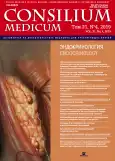Polyglandular autoimmune syndrome in adults: molecular genetic and clinical characteristics (lecture)
- Authors: Troshina E.A.1, Larina A.A.1, Terekhova M.A.2
-
Affiliations:
- Endocrinology Research Centre
- I.M. Sechenov First Moscow State Medical University (Sechenov University)
- Issue: Vol 21, No 4 (2019)
- Pages: 91-96
- Section: Articles
- URL: https://journals.rcsi.science/2075-1753/article/view/96861
- DOI: https://doi.org/10.26442/20751753.2019.4.190361
- ID: 96861
Cite item
Full Text
Abstract
Full Text
##article.viewOnOriginalSite##About the authors
Ekaterina A. Troshina
Endocrinology Research Centre
Email: *troshina@inbox.ru
Corr. Memb. RAS, D. Sci. (Med.), Full Prof. Moscow, Russia
Anna A. Larina
Endocrinology Research CentreEndocrinologist Moscow, Russia
Maria A. Terekhova
I.M. Sechenov First Moscow State Medical University (Sechenov University)student Moscow, Russia
References
- Neufeld M, Blizzard R.M. Polyglandular autoimmune diseases. In: Pinchera A, Doniach D, Fenzi G.F, Baschieri L, ed. Symposium on Autoimmune Aspects of Endocrine Disorders. New York: Academic Press, 1980; p. 357-65.
- Gombos Z, Hermann R, Kiviniemi M et al. Analysis of extended human leukocyte antigen haplotype association with Addison's disease in three populations. Eur J Endocrinol 2007; 157: 757-61.
- Hansen M.P, Kahaly G.J. Autoimmune polyglandular syndromes Dtsch Med Wochenschr 2013; 138 (7): 319-26; quiz 327-8. doi: 10.1055/s-0032-1327355
- Kahaly G.J. Polyglandular autoimmune syndromes. Eur J Endocrinol 2009; 161 (1): 11-20.
- Betterle C, Lazzarotto F, Presotto F. Autoimmune polyglandular syndrome Type 2: the tip of an iceberg? Clin Exp Immunol 2004; 137 (2): 225-33.
- Diagnostic criteria in autoimmune diseases. Y Shoenfeld, R Cervera, ME Gershwin, eds. Humana Press, Totowa, NJ. 2008.
- Betterle C, Dal Pra C, Mantero F, Zanchetta R. Autoimmune Adrenal Insufficiency and Autoimmune Polyendocrine Syndromes: Autoantibodies, Autoantigens, and Their Applicability in Diagnosis and Disease Prediction. Endocr Rev 2002; 23 (3): 327-64. https://doi.org/10.1210/edrv.23.3.0466
- Betterle C, Volpato M, Greggio A.N., Presotto F. Type 2 polyglandular autoimmune disease (Schmidt's syndrome). J Pediatr Endocrinol Metab 1996; 9 (1): 113-23.
- Albergoni P, Gazzola M.V, Slanzi E et al. HLA-DR and DQ associations with autoimmune Addison's disease in Italian patients. Genes Immunity 2003; 4 (1): S35.
- Betterle C, Zanchetta R. Update on autoimmune polyendocrine syndromes (APS). Clinical Immunology and Allergology. Acta Bio Medica 2003; 74: 9-33.
- Golden B, Levin L, Ban Y et al. Genetic analysis of families with autoimmune diabetes and thyroiditis: evidence for common and unique genes. J Clin Endocrinol Metab 2005; 90 (8): 4904-11.
- Kahaly G.J, Frommer L, Schuppan D. Celiac Disease and Glandular Autoimmunity. Nutrients 2018; 10 (7): 814. doi: 10.3390/nu10070814
- Fan K.C, Yang T.H, Huang Y.C. Vitiligo and thyroid disease: a systematic review and meta-analysis. Eur J Dermatol 2018; 28 (6): 750-63. doi: 10.1684/ejd.2018.3449.
- Vrijman C, Kroon M.W, Limpens J et al. The prevalence of thyroid disease in patients with vitiligo: a systematic review. Br J Dermatol 2012; 167 (6): 1224-35. doi: 10.1111/j.1365-2133
- Klein J, Stato A. The HLA System. First of two Parts. N Engl J Med 2000; 343: 702-9.
- Klein J, Stato A. The HLA System. Second of two Parts. N Engl J Med 2000; 343: 782-6.
- Huang W, Connor E, Dela Rosa T et al. Although DR3-DQB1*0201 may be associated with multiple component diseases of the Autoimmune Polyglandular Syndrome, the Human Leukocyte Antigen DR4-DQB1*0302 haplotype is implicated only in beta-cells autoimmunity. J Clin Endocrinol Metab 1996; 81: 2259-63.
- Erichsen M, Løvås K, Skinningsrud B et al. Clinical, Immunological, and Genetic Features of Autoimmune Primary Adrenal Insufficiency: Observations from a Norwegian Registry. J Clin Endocrinol Metab 2009; 94 (12): 4882-90.
- Flesch B.K, Matheis N, Alt T et al. HLA class II haplotypes differentiate between the adult autoimmune polyglandular syndrome types II and III. J Clin Endocrinol Metab 2014; 99 (1): E177-82. doi: 10.1210/jc.2013-2852
- Triolo T.M, Baschal E.E, Armstrong T.K et al. Homozygosity of the Polymorphism MICA5.1 Identifies Extreme Risk of Progression to Overt Adrenal Insufficiency among 21-Hydroxylase Antibody-Positive Patients with Type 1 Diabetes. J Clin Endocrinol Metab 2009; 94 (11): 4517-23.
- Huber A, Menconi F, Corathers S et al. Joint genetic susceptibility to type 1 diabetes and autoimmune thyroiditis: from epidemiology to mechanisms. Endocr Rev 2008; 29: 697-725.
- Villano M.J.B, Huber A.K, Greenberg D.A et al. Autoimmune thyroiditis and diabetes: dissecting the joint genetic susceptibility in a large cohort of multiplex families. J Clin Endocrinol Metab 2009; 94: 1458-66.
- Houcken J, Degenhart C, Bender K et al. PTPN22 and CTLA-4 Polymorphisms Are Associated With Polyglandular Autoimmunity. J Clin Endocrinol Metab 2018; 103 (5): 1977-84. doi: 10.1210/jc.2017-02577
- Dultz G, Matheis N, Dittmar M et al. CTLA-4 CT60 polymorphism in thyroid and polyglandular autoimmunity. Horm Metab Res 2009; 41 (6): 426-9.
- Skinningsrud B, Husebye E.S, Gervin K et al. Mutation screening of PTPN22: association of the 1858T-allele with Addison's disease. Eur J Human Genetics 2008; 16: 977-82.
- Никонова Т.В. Сахарный диабет 1 типа и латентный аутоиммунный диабет взрослых (LADA): клинические, иммуно-генетические и гормонально-метаболические аспекты. Автореф. дис.. д-ра мед. наук. М., 2011.
- Owen C.J, Eden J.A, Jennings C.E et al. Genetic association studies of the FOXP3 gene in Graves' disease and autoimmune Addison's disease in the United Kingdom population. J Mol Endocrinol 2006; 37 (1): 97-104.
- Lopez E.R, Lange B, Kahles H et al. Insulin gene polymorphisms in type 1 diabetes, Addison's disease and the polyglandular autoimmune syndrome type II. BMC Med Genet 2008; 9: 65.
- Lopez E.R, Zwermann O, Segni M et al. A promoter polymorphism of the CYP27B1 gene is associated with Addison's disease, Hashimoto's thyroiditis, Graves' disease and type 1 diabetes mellitus in Germans. Eur J Endocrinol 2004; 151 (2): 193-7
Supplementary files






